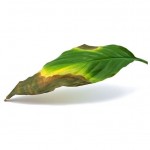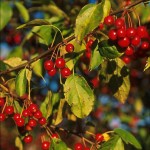These three Spring tree diseases common in our area sound like a horror movie. If you have a tree you love in your landscape, look out! One of these diseases may be about to creep its way in to make your trees look horrible! The important thing to remember about these diseases, is early Spring is the time for Prevention. The ugly spots and symptoms of these diseases will show up later in the year, when it’s too late to do any treatment for control.
Anthracnose
 Antracnose causes black or brown blotches to appear on leaves starting in late Spring. Severe infections cause early leaf drop in the Summer. The infection is caused by spores germinating on wet leaf surfaces. Cool, wet Spring weather creates favorable conditions for this disease. This disease attacks many trees including Sycamore, Oak, Maple, Walnut and Ash. You can better manage Anthracnose by raking and destroying infected leaves from under the tree in the early Spring, or even better, in the Fall. Apply preventative disease sprays and fertilize to help to manage the infections. Some species of specific trees are better than others, so seek out resistant plant varieties.
Antracnose causes black or brown blotches to appear on leaves starting in late Spring. Severe infections cause early leaf drop in the Summer. The infection is caused by spores germinating on wet leaf surfaces. Cool, wet Spring weather creates favorable conditions for this disease. This disease attacks many trees including Sycamore, Oak, Maple, Walnut and Ash. You can better manage Anthracnose by raking and destroying infected leaves from under the tree in the early Spring, or even better, in the Fall. Apply preventative disease sprays and fertilize to help to manage the infections. Some species of specific trees are better than others, so seek out resistant plant varieties.
Apple Scab

Apple Scab is most common on fruit trees especially Apples and Crabapples. Much like Anthracnose, it causes blotches and lesions on leaves in the Spring. Severe infections cause early leaf drop in the Summer. Again, cool, wet Spring weather is very conducive for this disease. Crabapples are the most common tree affected in home landscapes. Proper disease management is the same as listed above in regards to Anthracnose. Rake and destroy infected leaves from under the tree in the early Spring, or even better, in the Fall. Apply preventative disease sprays and fertilize these trees to help to manage the infections. Some species of specific trees are better than others, so seek out resistant plant varieties.
 Rust
Rust
Rust is another disease found in home landscape in the Spring. All rusts require a living host to complete their life cycle. For example, Cedar Apple Rust is found on Crabapples with Juniper as a common host plant. These two host plants are called “symbiotic hosts”. At one point of the year, you could see the Rust on a Juniper. On Crabapples it appears as a small wart like protrusion on the underside of leaves. Cool, wet Spring weather creates a favorable environment for infection. Removal of the host plant is the best way to manage this infection. If there are any Junipers in close proximity to the Crabapple, remove them and replace with a different plant. Spraying disease control applications in the Spring will also reduce the infection.
The Solution
The important, common thread here is prevention of diseases. When the tree looks stressed and defoliated in Summer, it’s too late to treat that season. Spraying these plants with the proper labeled fungicide, at the proper time is key for disease management. Spray intervals will vary, but a good Tree Care company will be able to time these applications to make your trees look their best.

